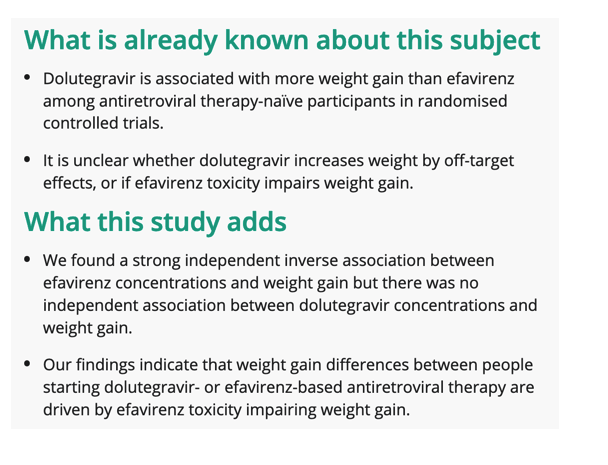| |
Concentration-response relationships of dolutegravir and efavirenz with weight change after starting antiretroviral therapy
|
| |
| |
Download the PDF here
26 December 2021
Abstract

Dolutegravir is associated with more weight gain than efavirenz in people starting antiretroviral therapy (ART). We investigated the concentration-response relationships of efavirenz and dolutegravir with weight gain. We determined concentration-response relationships of dolutegravir and efavirenz (both combined with tenofovir disoproxil fumarate and emtricitabine) with changes in weight and fat distribution, derived from dual-energy x-ray absorptiometry scans, in a nested study of ART-naïve participants from a randomised controlled trial. Pharmacokinetic parameters used in analyses were efavirenz mid-dosing interval concentrations and estimated dolutegravir area under the concentration-time curve using a population pharmacokinetic model developed in the study population. Study outcomes were percentage changes from baseline to week 48 in weight, and visceral and subcutaneous adipose tissue mass. Pharmacokinetic data were available for 158 and 233 participants in the efavirenz arm and dolutegravir arms respectively; 57.0% were women. On multivariable linear regression there were independent negative associations between efavirenz concentrations and changes in both weight (P < .001) and subcutaneous adipose tissue mass (P = .002). Estimated dolutegravir area under the concentration-time curve up to 24 hours was not associated with change in weight (P = .109) but was negatively associated with change in visceral adipose tissue mass (P = .025). We found an independent negative concentration-response relationship between efavirenz concentrations and weight change in ART-naïve participants. Dolutegravir concentrations were not independently associated with weight change. These findings suggest that weight gain differences between efavirenz and dolutegravir are driven by efavirenz toxicity impairing weight gain rather than by off-target effects of dolutegravir causing weight gain.
INTRODUCTION
Integrase strand transfer inhibitors (InSTIs) are associated with more weight gain than other classes of antiretrovirals among people living with HIV (PLWH) initiating antiretroviral therapy (ART) in randomised controlled trials.1-3 Two randomised controlled trials conducted in ART-naïve PLWH in sub-Saharan Africa reported that dolutegravir-based regimens were associated with more weight gain (especially among women) than efavirenz-based regimens.2, 3 There are 2 potential explanations for the greater weight gain with dolutegravir than efavirenz: dolutegravir may have off-target effects that stimulate appetite or perturb metabolism, or efavirenz may impair weight gain through its metabolic or neuropsychiatric toxic effects. Dolutegravir inhibits the melanocortin 4 receptor (MC4R),4 which is associated with energy homeostasis and appetite regulation.5, 6 Efavirenz causes concentration-dependent mitochondrial toxicity, impaired adipocyte differentiation, and neuropsychiatric adverse drug reactions that could impair appetite.7-9
Efavirenz is primarily metabolised by the cytochrome P450 2B6 enzyme (CYP2B6). Polymorphisms coding loss-of-function in the CYP2B6 gene result in higher efavirenz concentrations.10 Leonard et al. reported greater weight gain among CYP2B6 slow metabolisers on efavirenz-based ART when switched to an InSTI-based regimen.11 We recently showed that CYP2B6 metaboliser genotype was strongly associated with weight change among PLWH starting efavirenz-based ART: extensive metabolisers gained the most weight, and slow metabolisers lost weight.12 We also observed that CYP2B6 extensive metabolisers in the efavirenz arm had similar weight gain to participants in the dolutegravir arm, supporting the hypothesis that weight gain on dolutegravir-based ART is not due to off target effects of dolutegravir, but rather that impaired weight gain on efavirenz-based ART is due to concentration-dependent efavirenz toxicity. These 2 studies showing associations between CYP2B6 metaboliser genotype and weight gain differences between InSTIs and efavirenz suggest, but do not confirm, an inverse concentration-response relationship between efavirenz and weight gain. Establishing a concentration-response relationship is important as it is 1 of Bradford Hill's criteria for establishing causation.13
We hypothesised that among PLWH initiating ART there is an inverse concentration-response relationship between efavirenz and weight gain, and that there is no concentration-response relationship between dolutegravir and weight gain. We determined efavirenz and dolutegravir drug concentrations in participants from the ADVANCE study3 on identical nucleoside reverse transcriptase inhibitors (emtricitabine and tenofovir disoproxil fumarate [TDF]) to determine concentration-response relationships with change in weight over 48 weeks.
|
|
| |
| |
|
|
|